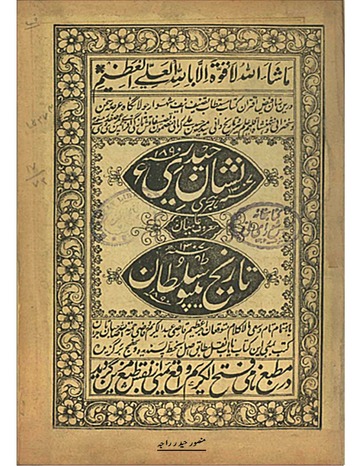Fathul Mujahidin on:
[Wikipedia]
[Google]
[Amazon]

 ''Fathul Mujahidin (Victory of the Mujahids),'' was written in 1783 by Zainul Abedin Shustari at the instruction of
''Fathul Mujahidin (Victory of the Mujahids),'' was written in 1783 by Zainul Abedin Shustari at the instruction of
with 16 to 24 cushoons of

 ''Fathul Mujahidin (Victory of the Mujahids),'' was written in 1783 by Zainul Abedin Shustari at the instruction of
''Fathul Mujahidin (Victory of the Mujahids),'' was written in 1783 by Zainul Abedin Shustari at the instruction of Tipu Sultan
Tipu Sultan (, , ''Sultan Fateh Ali Sahab Tipu''; 1 December 1751 – 4 May 1799) commonly referred to as Sher-e-Mysore or "Tiger of Mysore", was a ruler of the Kingdom of Mysore based in South India. He was a pioneer of rocket artillery ...
, is a work on the rules and regulations for the army describing the duties of a soldier engaged in Jihad (Holy War). Mysore started to equip their army with rockets in the 1750s and during the Second Anglo–Mysore War (1780–1784) Tipu and his father Haider Ali used this technology against British troops. Tipu Sultan used rockets in battle with the British Army
The British Army is the principal Army, land warfare force of the United Kingdom. the British Army comprises 73,847 regular full-time personnel, 4,127 Brigade of Gurkhas, Gurkhas, 25,742 Army Reserve (United Kingdom), volunteer reserve perso ...
in the 1792 Siege of Srirangapatna, a battle at the end of the Third Anglo-Mysore War
The Third Anglo-Mysore War (1790–1792) was a conflict in South India between the Kingdom of Mysore and the British East India Company, the Travancore, Kingdom of Travancore, the Maratha Empire, Maratha Confederacy, and the Nizam of Hyderabad ...
.
Tipu distributed copies of his military manual to all of his officers. In the manual he defined 200 men to handle rockets within each of the Mysore
Mysore ( ), officially Mysuru (), is a city in the southern Indian state of Karnataka. It is the headquarters of Mysore district and Mysore division. As the traditional seat of the Wadiyar dynasty, the city functioned as the capital of the ...
br>cushoonswith 16 to 24 cushoons of
infantry
Infantry, or infantryman are a type of soldier who specialize in ground combat, typically fighting dismounted. Historically the term was used to describe foot soldiers, i.e. those who march and fight on foot. In modern usage, the term broadl ...
. The personnel handling the rockets were trained to define the launch angle to properly affect the curve at which the rocket would land. Tipu also defined in the manual a multiple rocket launcher (much like a musical organ) that would launch up to 10 rockets. Some of the rockets had blades in the front of the bamboo guiding rods, while others were designed as incendiary rockets.
Although not the first use of rockets by Mysore, the 1792 Siege of Srirangapatna reportedly began with showers of as many as 2,000 rockets fired simultaneously.
According to Stephen Oliver Fought and John F. Guilmartin, Jr. in ''Encyclopædia Britannica
The is a general knowledge, general-knowledge English-language encyclopaedia. It has been published by Encyclopædia Britannica, Inc. since 1768, although the company has changed ownership seven times. The 2010 version of the 15th edition, ...
'' (2008):
See also
*Congreve rocket
The Congreve rocket was a type of rocket artillery designed by British inventor Sir William Congreve, 2nd Baronet, Sir William Congreve in 1808.
The design was based upon Mysorean rockets, the rockets deployed by the Kingdom of Mysore against ...
*Hyder Ali
Hyder Ali (''Haidar'alī''; ; 1720 – 7 December 1782) was the Sultan and ''de facto'' ruler of the Kingdom of Mysore in southern India. Born as Hyder Ali, he distinguished himself as a soldier, eventually drawing the attention of Mysore's ...
*Tipu Sultan
Tipu Sultan (, , ''Sultan Fateh Ali Sahab Tipu''; 1 December 1751 – 4 May 1799) commonly referred to as Sher-e-Mysore or "Tiger of Mysore", was a ruler of the Kingdom of Mysore based in South India. He was a pioneer of rocket artillery ...
* Mughal weapons
References
External links
{{cite web , title=The Tiger and The Thistle , url=http://www.tigerandthistle.net , focussing on Tipu Sultan and the Scots in India, 1760–1800 Military handbooks and manuals Early rocketry Rocket artillery Kingdom of Mysore Artillery of India 18th-century Indian books